Gubbins D., Herrero-Bervera E. Encyclopedia of Geomagnetism and Paleomagnetism
Подождите немного. Документ загружается.

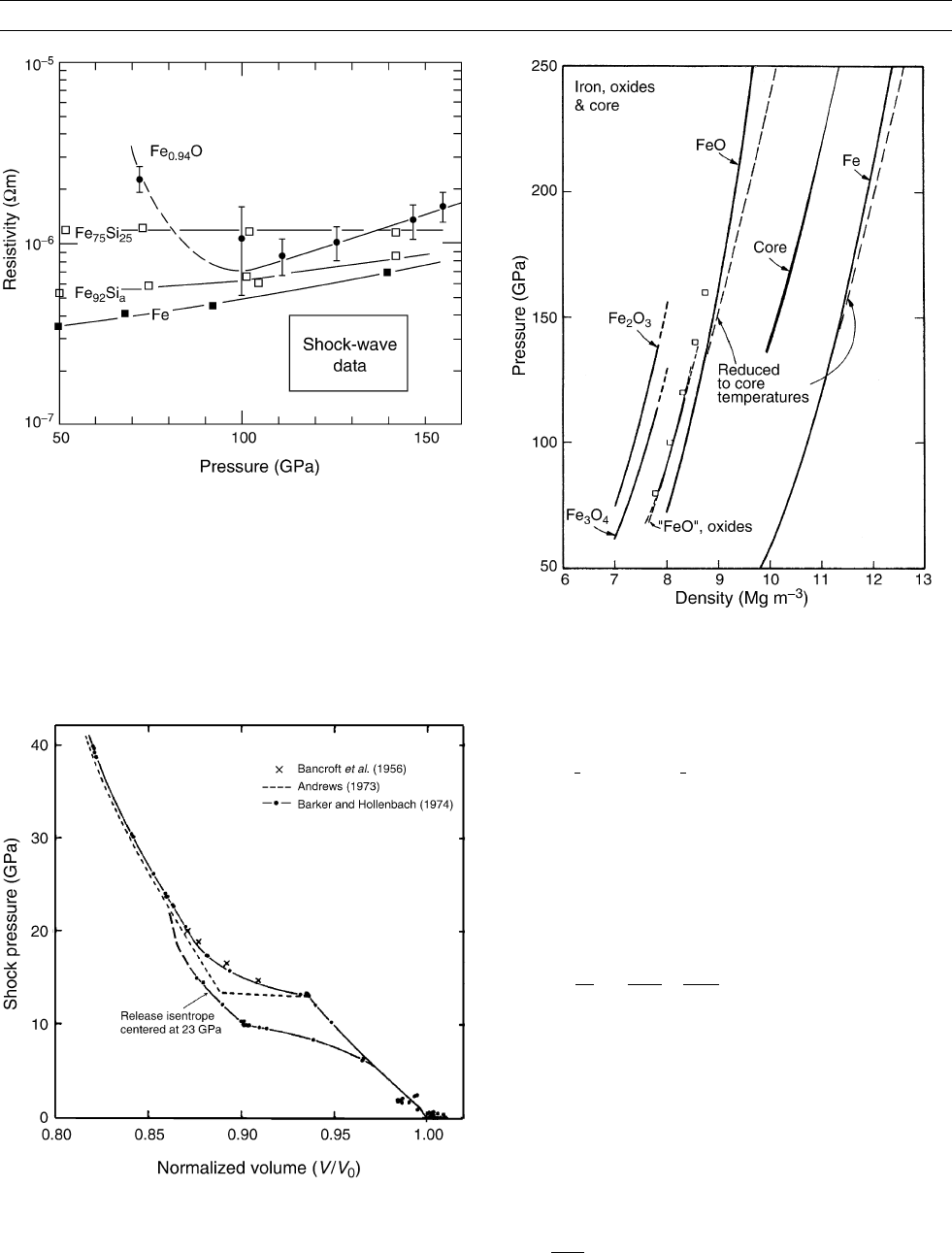
iron). The Grüneisen parameter is given by (see Grüneisen’s para-
meter for iron and Earth’s core):
g ¼ V
]P
]E
V
¼
aK
s
C
p
r
0
¼
aK
T
r
0
C
V
; (Eq. 8)
where, a, K
s
, K
T
, C
p
, and C
v
are the thermal expansion coefficient,
isentropic and isothermal bulk modulus, and specific heat at constant
pressure and volume. Equation (8) is used to evaluate g at ambient
pressures.
Determining Gru
¨
neisen parameter
The Grüneisen parameter at high pressure is obtained from the mea-
sured bulk sound velocity, C, behind the shock front and is given as
(see Grüneisen’s parameter for iron and Earth’s core):
g ¼
r
0
rs
2
1 þ s R
2
ð1 sÞ
; (Eq. 9)
when
¼ u
1
=U ¼ðV
0
V Þ=V
0
(Eq. 10)
Figure S39 Shock -wave data for FeO (Jeanloz and Ahrens, 1980),
Fe (McQueen et al., 1970), Fe
2
O
3
and Fe
3
O
4
(McQueen and
Marsh, quoted in Birch (1966); not corrected for porosity)
(heavy curves) compared with the seismologically determined
compression curve of the core. The Fe and FeO data, corrected to
core temperatures, are shown as thin dashed curves. Hugoniots of
mixtures of oxides and Fe corresponding to FeO are given as
thin curves;
1
3
(Fe þ Fe
2
O
3
),
1
4
(Fe þ Fe
3
O
4
) and (Fe
3
O
4
–Fe
2
O
3
) are
plotted but overlap; open squares are from Al’tshuler and
Sharipdzhanov (1971). Hugoniots for only the high-pressure
phase are shown, and the wu
¨
stite data are corrected for initial
porosity and nonstoichiometry (after Jeanloz and Ahrens (1980)).
Figure S38 Hugoniot shock pressure versus reduced volume
(V/V
0
) data for g-iron. Upon shock loading, the onset of phase
change which a-iron (bcc) transforms to e-iron (hcp) with a 5%
decrease in volume occurs at 13 GPa. Upon unloading from
23 GPa dynamic transformation from hcp to bcc-iron occurs at
10 GPa. The data are from Bancroft et al. (1956) and Barker and
Hollenbach (1974). Dashed curve (Andrews, 1973) is theoretical
curve.
Figure S37 Measurements of the electrical resistivity of Fe
0.94
O
under shock loading are compared with previous data for iron and
two iron-silicon alloys, iron, iron alloys, and compounds versus
shock pressure (after Knittle et al. (1986)). Upon extrapolating
these data to the pressure range of core (135–450 GPa), it can be
concluded that these iron-bearing minerals have resistivities of
10
6
–10
5
O m at core pressures and temperatures.
916 SHOCK WAVE EXPERIMENTS
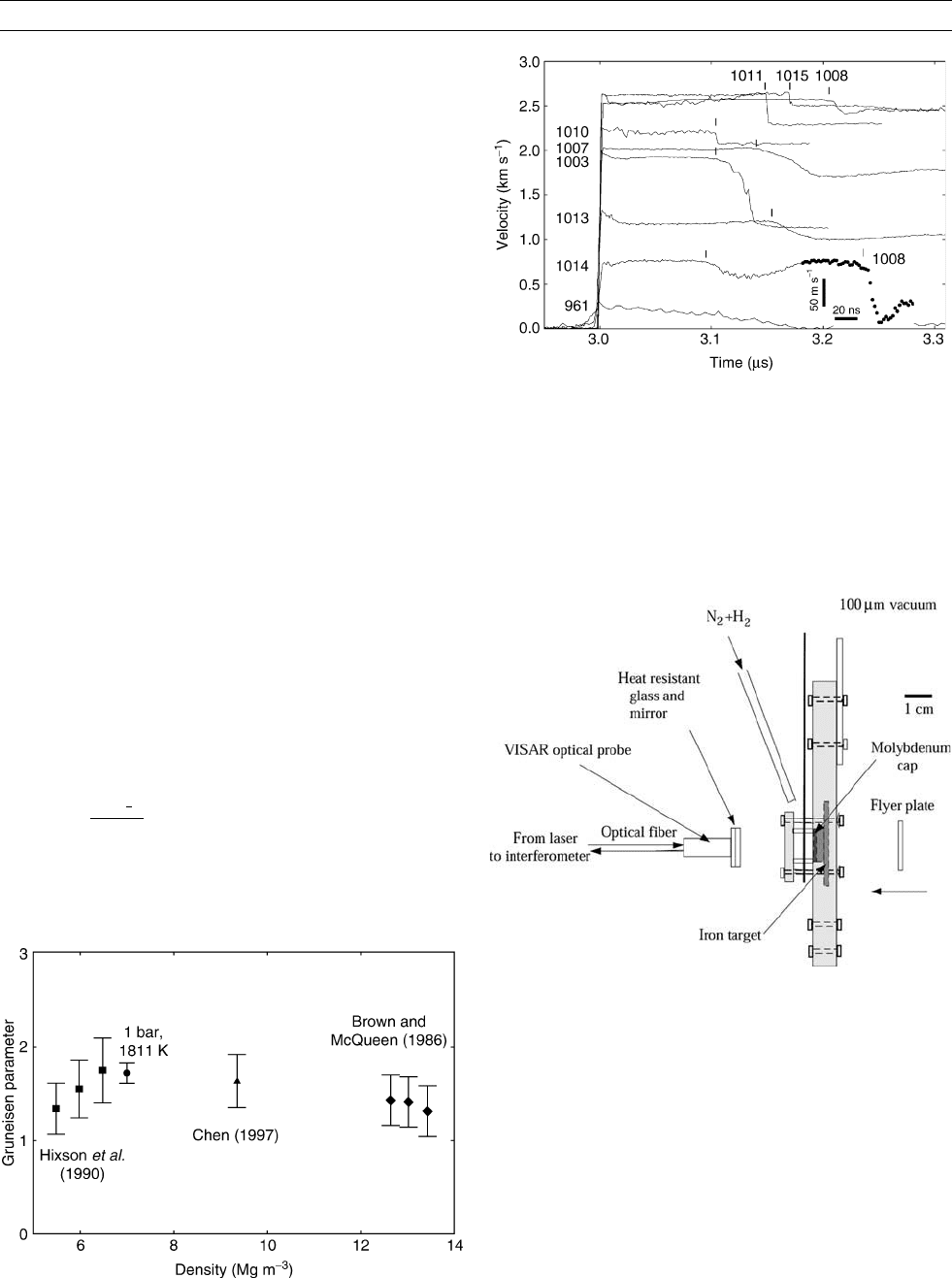
and
R
¼ðr=r
0
Þðc=UÞ: (Eq. 11)
The derivation of (9) assumes that the Hugoniot shock and particle
relation are described by:
U ¼ c
0
þ su
1
; (Eq. 12)
where
c
0
¼
ffiffiffiffiffiffiffiffiffiffiffiffiffiffi
K
os
=r
0
p
(Eq. 13)
and
s ¼ K
0
os
þ 1
=4: (Eq. 14)
By measuring the free-surface velocity profiles of shock states being
overtaken by rarefactions originating at the rear of the iron flyer plate,
the sound velocity c (and hence g) of different states along the princi-
pal Hugoniot and 1373 K preheated Hugoniot of g-iron may be
obtained as a function of density or specific volume (Figure S40).
From a series of free-surface profiles, such as shown in Figure S41,
data on the value of c, and hence g (Ahrens et al., 2002a) can be
obtained, for example, for preheated iron, using apparatus depicted
in Figure S42.
Detection of shock-induced melting
As described above, the bulk sound velocities can be measured for
shock states achieved in molten materials,
c ¼
ffiffiffiffiffiffiffiffiffiffiffiffi
K
s
=r
0
p
: (Eq. 15)
In the solid regime, the rarefaction wave propagates with the longitu-
dinal elastic velocity which is given by:
V
p
¼
ffiffiffiffiffiffiffiffiffiffiffiffiffiffiffiffi
K
s
þ
4
3
m
r
0
s
: (Eq. 16)
Thus by measuring the sound velocity as a function of shock pressure,
the shock pressure upon which the sound velocity decreases sharply,
indicates where the Hugoniot curve enters the regime of trans-
formation from the solid, into the partially molten and then completely
liquid regime. Knowledge of the Grüneisen parameter at high pres-
sure and temperature (9–11) and thermodynamic calculations allow
construction of the high pressure-temperature phase diagram (Brown
and McQueen, 1986; Ahrens et al., 2002b; Nguyen and Holmes,
2004) (see Melting temperature of iron in the core, theory and Melting
temperature of iron in the core, experiment).
Very extensive data for iron, centered at normal temperatures (Fig-
ure S43), demonstrates that shock-induced melting begins at
220 GPa (Brown and McQueen, 1986; Nguyen and Holmes, 2004).
The sound velocity of the Hugoniot of other metals is also available
for Al, Cu, Ta, Pb, Mo, W, V, and stainless steel (Dai et al., 2002;
Luo and Ahrens, 2004). Shock temperatures upon melting, for all these
Figure S41 Free-surface velocity profiles from VISAR experiments
in geometry of Figures S33 and S42 on iron preheated to 1373 K.
Shot numbers are shown near each wave profile. Vertical lines
indicate initial unloading arrivals. Peak particle velocities are
within 4% of impedance match solutions. Origin of time axis
is arbitrary. Inset: detailed plot of first release wave arrival for shot
1008 (after Chen (1997)).
Figure S42 Experimental arrangement for conducting VISAR
sound speed measurements in preheated 1373 K iron (after Chen
and Ahrens (1998)).
Figure S40 Thermodynamic Gru
¨
neisen parameter g of liquid iron
versus density. The 1 bar, 1811 K datum is from Anderson and
Ahrens (1994). “This study” with “Chen (1997).”
SHOCK WAVE EXPERIMENTS 917
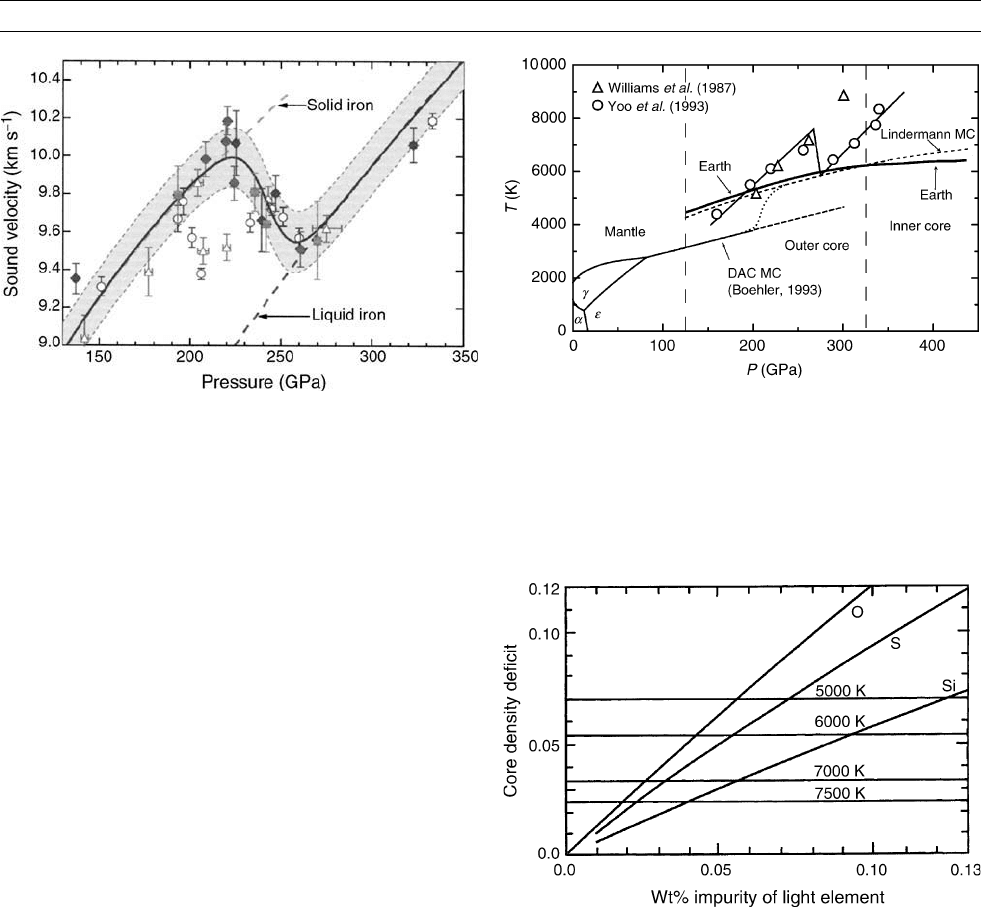
metals and other materials of geophysical interest were calculated.
These calculations are substantially verified by the, at present, limited
shock temperature and high pressure melting data which are measured
for iron (Williams et al., 1987; Yoo et al., 1993), V (Dai et al., 2001),
FeS and FeS
2
(Anderson and Ahrens, 1996), and stainless steel
(Ahrens et al., 1990). Moreover, recent studies of melting in the Fe-O
and Fe-S system in diamond anvil apparatus indicate that eutectic
melting temperatures of plausible iron alloys are lowered from those
of iron by <500 K at core pressures (Boehler, 1992, 2000). The above
referenced iron and iron alloys data have indicated the IC-OC melting
temperature of approximately 6000 500 K. These values have pro-
foundly influenced models of the core as discussed in the next section.
Influence of shock wave data on models of the core
Thermal models of the Earth’s core of the 1970s (e.g., Stacey (1977))
were, in part, based on extrapolation of 10 GPa melting data for the
FeS eutectic (Usselman, 1975a, b). Stacey and others modeled
the outer core as having temperature of 3200 K at CMB rising to
4200 K at the IC-OC boundary. The shock temperatures first calculated
by Brown and McQueen (1986) on the basis of their pioneering study of
the shock temperature upon melting along the principal Hugoniot of iron
at 220 GPa (5000– 5700 K) extrapolated to 5800 500 K for melting of
iron at the IC-OC boundary. Later shock temperature measurements
(Figure S44) supported these considerably higher temperatures. The
shock temperatures for iron when applied to the core indicates higher
(by 1000 K) melting points than static high pressure diamond anvil
melting data to 200 GPa (Boehler, 1993). Present models of
the Earth’s core assume IC-OC temperature of 5000–6000 K (e.g.,
Poirier (1994), Anderson and Ahrens (1994), Boehler (2000), Anderson
(2002)) are summarized by the temperature-pressure relation labeled
Earth (representing the outer and inner core) in Figure S44, were influ-
enced by the shock-induced melting data for iron. These rather higher
values lead to rather larger predicted heat flows from the core of
6–10 Tw, compared to the previous assumed values of CMB heat flow
of 4–5 Tw of Matassov (1977). High temperature core values lead
to implausibly short model existence times of the solid Earth core
(Labrosse et al., 2001). This then leads to possible, but still very poorly
constrained models, of radioactive element contents of the core. Such
models of radiogenic heat production lead to higher sustained core
temperatures over the history of the Earth (Buffett, 2003).
As can be seen in Figure S45, as the model values of outer core tem-
peratures are increased from 5000 to 7000 K, the calculated density
deficit (with respect to molten iron at that temperature largely on the
basis of shock wave data for FeS, FeO, and FeSi) goes down from
7 to 3.5% and the wt% of impurity of light element decreases drasti-
cally (see Core, adiabatic gradient and Core composition).
Acknowledgments
I am grateful to William Nellis for a number of suggestions that
improved this manuscript. Research supported by NSF EAR-
0207934. Contribution No. 9039, Division of Geological and Plane-
tary Sciences, California Institute of Technology, Pasadena, CA.
Thomas J. Ahrens
Figure S44 Shock temperature data for iron relative to the
temperatures in the outer and inner core. States between 200
and 250 GPa are assigned to solid e-iron driven to temperatures
above melting line (Lindemann MC, melting curve). States above
270 GPa are believed to represent totally melted material. DAC
MC is diamond anvil melting curve (after Luo and Ahrens (2004)).
Figure S43 Sound velocity upon unloading rarefaction upon
shock compression of a-iron. Solid symbols exhibit a single
solid-liquid transition along Hugoniot at 222 3 GPa (according
to Nguyen and Holmes (2004)). Brown and McQueen’s (1986)
data are shown by open symbols. Open squares (triangles)
represent (explosive driven) shock data (after Nguyen and
Holmes (2004)).
Figure S45 Core density deficit in terms of wt% of three
cosmochemically acceptable elements. Four parallel lines
represent the value of T
m
at IC-OC (330 GPa) corresponding to
temperatures indicated. Intersection of these parallel lines with
curves for Si, S, and O indicate wt% values of element (after
Anderson and Isaak (2002)).
918 SHOCK WAVE EXPERIMENTS

Bibliography
Ahrens, T.J., 1987. Shock wave techniques for geophysics and plane-
tary physics. In Sammis, C.G., and Henyey, T.L. (eds.), Methods of
Experimental Physics, Volume 24, Part A. New York: Academic
Press, pp. 185–235.
Ahrens, T.J., and Jeanloz, R., 1987. Pyrite: shock compression, isen-
tropic release, and composition of the Earth ’s core. Journal of Geo-
physical Research, 92: 10363–10375.
Ahrens, T.J., and Johnson, M.L., 1995. Shock wave data for minerals.
In Ahrens, T.J. (ed.), Mineral Physics and Crystallography, A
Handbook of Physical Constants, Volume 2. Washington, DC:
American Geophysical Union, pp. 143–183.
Ahrens, T.J., Bass, J.D., and Abelson, J.R., 1990. Shock temperatures
in metals. In Schmidt, S.C., Johnson, J.N., and Davison, L.W.
(eds.), Shock Compression of Condensed Matter—1989. Amster-
dam: Elsevier Publishers, pp. 851–857.
Ahrens, T.J., Holland, K.G., and Chen, G.Q., 2002a. Phase diagram of
iron, revised-core temperatures. Geophysical Research Letters, 29:
54-1–54-4. doi:10.1029/2001GL014350.
Ahrens, T.J., Xia, K., and Coker, D., 2002b. Depth of cracking beneath
impact craters: new constraint for impact velocity. In Furnish, M.D.,
Thadhani, N.N., and Horie, Y. (eds.), Shock-Compression of Con-
densed Matter—2001. New York: American Institute of Physics,
pp. 1393–1396.
Al’tshuler, L.V., and Sharipdzhanov, I.I., 1971. Additive equations of
state of silicates at high pressures. Izvestiya, Earth Physics, English
Translation, 3: 167–177.
Al’tshuler, L.V., Trunin, R.F., Urlin, V.D., et al.,1999. Development of
dynamic high-pressure techniques in Russia. Physics-Uspekhi, 42:
261–280.
Anderson, O.L., 2002. The power balance at the core-mantle bound-
ary. Physics of the Earth and Planetary Interiors, 131:1–17.
Anderson, W.W., and Ahrens, T.J., 1994. An equation of state for
liquid iron and implications for the Earth’s core. Journal of Geo-
physical Research, 99: 4273–4284.
Anderson, W.W., and Ahrens, T.J., 1996. Shock temperatures and
melting in iron sulfides at core pressures. Journal of Geophysical
Research, 101: 5627–5642.
Anderson, O.L., and Isaak, D.G., 2002. Another look at the core den-
sity deficit of Earth’s outer core. Physics of the Earth and Plane-
tary Interiors, 131:19–27.
Andrews, D.J., 1973. Equation of state of the alpha and epsilon phase
of iron. Journal of Physics in Chemical Solids, 34: 825–840.
Bancroft, D., Peterson, E.L., and Minshall, S., 1956. Polymorphism of
iron at high pressure. Journal of Applied Physics, 27: 291–298.
Barker, L.M., and Hollenbach, R.E., 1974. Shock wave study of the
ae transition in iron. Journal of Applied Physics, 45: 4872–4887.
Birch, F., 1966. Compressibility: elastic constants. In Clark, S.P., Jr.
(ed.), Handbook of Physical Constants, revised edition. New York:
The Geological Society of America, pp. 153–159. Bloxham, J.,
and Gubbins, D., 1985. Nature, 317: 777.
Boehler, R., 1992. Melting of the Fe-FeO and Fe-FeS systems at high
pressure: constraints on core temperatures. Earth and Planetary
Science Letters, 111: 217–227.
Boehler, R., 1993. Temperatures in the Earth’s core from melting-point
measurements of iron at high pressures. Nature, 363: 534–536.
Boehler, R., 2000. High-pressure experiments and the phase diagram
of lower mantle and core materials. Reviews of Geophysics, 38:
221–245.
Brown, J.M., and McQueen, R.G., 1986. Phase transitions, Grüneisen
parameter, and elasticity for shocked iron between 77 GPa and 400
GPa. Journal of Geophysical Research, 91: 7485–7494.
Brown, J.M., Ahrens, T.J., and Shampine, D.L., 1984. Hugoniot data
for pyrrhotite and the Earth’s core. Journal of Geophysical
Research,
89: 6041–6048.
Buffett, B.A., 2003. The thermal state of Earth’s core. Science , 299:
1675–1676.
Chen, G., 1997. I. High pressure melting of g-iron and the thermal pro-
file in the Earth’s core, II. High pressure, high temperature equa-
tion of state of fayalite (Fe
2
SiO
4
). Ph.D. (major: physics) thesis,
Division of Physics, Mathematics, and Astronomy, California Insti-
tute of Technology, Pasadena, California.
Chen, G.Q., and Ahrens, T.J., 1998. High pressure and high tempera-
ture equation-of-state of gamma and liquid iron. In Wentzcovitch,
R.M., Hemley, R.J., Nellis, W.J., and Yu, P.Y. (eds.), High-Pres-
sure Materials Research. Materials Research Society Symposium
Proceedings, Warrendale, PA, 499, pp. 41–61.
Dai, C., Jin, X., Zhou, X., et al., 2001. Sound velocity variations and
melting of vanadium under shock compression. Journal of Physics
D: Applied Physics, 34: 3064–3070.
Dai, C., Tan, H., and Geng, H., 2002. Model for assessing the melting
on Hugoniots of metals: Al, Pb, Cu, Mo, Fe, and U. Journal of
Applied Physics, 92: 5019–5026.
Holzapfel, W.B., 1996. Physics of solids under strong compression.
Reports on Progress in Physics, 59:29–90.
Jeanloz, R., and Ahrens, T.J., 1978. The equation of state of a lunar
anorthosite: 60025. Lunar and Planetary Science Conference 9th.
Houston, TX: Pergamon Press, pp. 2789–2803.
Jeanloz, R., and Ahrens, T.J., 1980. Equations of state of FeO and
CaO. Geophysical Journal of the Royal Astronomical Society, 62:
505–528.
Knittle, E., Jeanloz, R., Mitchell, A.C., et al., 1986. Metallization of
Fe
0.94
O at elevated pressures and temperatures observed by
shock wave electrical resistivity measurements. Solid State Com-
munication, 59: 513–515.
Labrosse, S., Poirier, J.-P., and Le Mouël, J.-L., 2001. The age of the
inner core. Earth and Planetary Science Letters, 190: 111–123.
Luo, S.-N., and Ahrens, T.J., 2004. Shock-induced superheating and
melting curves of geophysically important minerals. Physics of
the Earth and Planetary Interiors, 143–144: 369–386.
Matassov, G., 1977. The electrical conductivity of iron-silicon alloy at
high pressures and the Earth’s core. Lawrence Livermore Labora-
tory, University of California.
McQueen, R.G., 1992. The velocity of sound behind strong shocks in
SiO
2
. In Tasker, D.G. (ed.), Shock Compression of Condensed Mat-
ter 1991. Amsterdam: Elsevier, pp. 75–78.
McQueen, R.G., Marsh, S.P., Taylor, J.W., et al.,1970. The equation
of state of solids from shock wave studies. In Kinslow, R. (ed.),
High-Velocity Impact Phenomena. New York: Academic Press,
pp. 293–417.
Melosh, H.J., 1989. Impact Cratering, A Geologic Process. New York:
Oxford University Press, 245 pp.
Nguyen, J.H., and Holmes, N.C., 2004. Melting of iron at the physical
conditions of the Earth’s core. Nature, 427: 339–342.
Poirier, J.-P., 1994. Light elements in the Earth’s outer core: a
critical review. Physics of the Earth and Planetary Interiors, 85:
319–337.
Stacey, F.D., 1977. A thermal model of the Earth. Physics of the Earth
and Planetary Interiors, 15: 341–348.
Stacey, F.D., 2001. Finite strain, thermodynamics and the earth’s core.
Physics of the Earth and Planetary Interiors, 128: 179–193.
Usselman, T.M., 1975a. Experimental approach to the state of the core:
Part I. The liquidus relations of the Fe-rich portion of the Fe-Ni-S
system from 30 to 100 kb. American Journal of Science, 275:
278–290.
Usselman, T.M., 1975b. Experimental approach to the state of the
core: Part II. Composition and thermal regime. American Journal
of Science, 275: 291–303.
Williams, Q., Jeanloz, R., Bass, J., et al.,1987. The melting curve of
iron to 250 Gigapascals: a constraint on the temperature at Earth’s
center. Science, 236: 181 –182.
Yoo, C.S., Holmes, N.C., Ross, M., et al.,1993. Shock temperatures
and melting of iron at Earth core conditions. Physical Review
Letters, 70: 3931–3934.
SHOCK WAVE EXPERIMENTS 919

Cross-references
Core Composition
Core Temperature
Core, Adiabatic Gradient
Grüneisen’s Parameter for Iron and Earth’s Core
Inner Core Composition
Melting Temperature of Iron in the Core, Experimental
Melting Temperature of Iron in the Core, Theory
SPINNER MAGNETOMETER
Introduction
The spinner magnetometer is an instrument for measuring remanent
magnetization (RM) of rock specimens in studies of the magnetic
properties of rocks.
Natural remanent magnetization (NRM) is the magnetic quantity,
which was preserved in the rock during its formation in the presence
of the prevailing magnetic field and then during its long-life existence
when it was exposed to many physical and chemical factors. Thus,
various sorts of RM may exist simultaneously and in different ratio
in the same rock. RM is a vector quantity. If the rock is magnetically
isotropic, the direction of the RM is identical with the direction of
the magnetic field at the time of rock formation. Strong anisotropy
usually causes a difference between the directions of the RM and the
magnetizing field. The spinner magnetometer measures the total
NRM, which is the sum of several RM vectors. The remanent mag-
netizations differ by their formation and have different stabilities.
Magnetization strengths are in the order of 10
–6
Am
1
for weakly
magnetized sediments to 10
2
Am
1
for strongly magnetized ores.
Typical spinner magnetometer applications are:
Paleomagnetism: Changes in Earth’s magnetic field in geological
history can be investigated through the measurement of the rock’s
remanent magnetization and in the investigation of its stability,
age-dating the rocks, solving some tectonic problems in particular
terrains, dating the development of mineralization of ore deposits,
and many other geological problems.
Archeomagnetism: Changes of Earth’s magnetic field in human
history. These investigations are mostly applicable to dating arche-
ological materials.
Mineralogy: Impurities of ferromagnetic grains in para- or diamag-
netic minerals can be investigated.
Magnetic fabric studies: Measurement of the anisotropy of isother-
mal remanent magnetization (IRM) can help in the separation of
ferromagnetic and paramagnetic fractions of a rock.
Magnetometry: In the interpretation of ground or airborne mag-
netic measurements it is useful to know whether the rock’s magne-
tization is due to its induced or remanent component. Investigation
of RM can help to solve this problem.
Measuring principles
The principle of measurement is very simple, based on electromag-
netic induction law formulated by Michael Faraday as early as 1831.
Rock specimen of defined size and shape, fixed in a specimen holder
rotates at a constant angular speed in the vicinity of a detector.
Provided that the spinning specimen has nonzero magnetic moment,
an AC voltage is induced in the detector. The detector is shielded with
a multilayer permalloy shield. At constant speed of rotation and con-
stant specimen size, the amplitude and phase of the induced signal
depend on the magnitude and direction of RM vector of the specimen.
The voltage is amplified, filtered, digitized, and analyzed. In a
specimen rotating about a single axis inside a pair of detector coils,
the output voltage amplitude is proportional to the projection of the
RM vector to the plane perpendicular to the rotation axis; the compo-
nent of the RM vector parallel to the rotation axis induces no signal.
The phase of the signal depends on the direction of projection of the
RM vector into the plane perpendicular to the rotation axis. To mea-
sure the third RM component, the specimen must be at least once repo-
sitioned by turning it by 90
and re-measured. In practice, the standard
measurement of the RM vector consists of successive measurements in
three, four, or six positions to reduce the measurement errors. The spe-
cimen position change is performed manually or using special auto-
matic manipulator, which turns the specimen between successive
spinning steps around the imaginary body diagonal of a cube which
has threefold symmetry. Thus, the automatic manipulator eliminates
the need of manual specimen positioning during the measuring process
and shortens the measuring time. The other solution is to use a special
specimen holder simultaneously spinning the specimen about two or
three axes. However, this solution usually results in decreasing the
sensitivity of the instrument due to the occurrence of additional
mechanical vibrations caused by the two axes spinning mechanism.
The induced signal is amplitude sensitive proportional to speed of
rotation and phase sensitive due to the band pass filtration of the signal
by the instrument hardware. For this reason a very precise stabil ization
of rotation speed is necessary. A reference signal synchronous to the
specimen rotation is needed for phase calibration, speed control, filtra-
tion, induced signal scanning, and digital processing. The reference
signal is generated by an optocoupler built right on specimen holder
shaft or in some cases into the motor unit. The magnetometer calibra-
tion is a special measurement procedure of the standard, which yields
the gain and phase for calculating the remanence vector components.
Since the specimen is fixed in the specimen holder, the measurement
procedure and specimen position design should eliminate the residual
RM value of the holder. If this is not possible due to principal reasons,
correction for the holder in the case of a weak specimen must be done
by subtracting the empty holder values from the data measured.
In general, the properties of the instrument depend upon the geo-
metric arrangement of the detector relative to the spinning specimen,
the type of detector and its size, homogeneity and geometric precision,
noise of detector, noise of electronic unit, speed of rotation, size and
homogeneity (magnetic and physical) of the specimen, the type of spe-
cimen holder, the influence of external disturbing fields, the resistance
to mechanical shock, and temperature.
Sensitivity of the spinner magnetometer
The signal detector is the heart of the instrument. The design of
the detector together with the preamplifier of the induced signal
significantly determines the sensitivity of the instrument. Since some
rocks have very low amplitude of the RM vector, of the order of
10
–5
–10
–6
Am
1
, the sensitivity of the instrument should be at least
in the order 10
–6
Am
1
.
Spinner magnetometer measurements are disturbed by noise, which
can be in three categories: First the thermal noise of the detector (pick-
up coils), second the noise of the electric circuits (preamplifier of the
induced signal and the control unit), and third the noise whose source
may be by various causes (impurities on the specimen holder, vibration
of the pick-up coils, strange external magnetic fields, etc.). The sum of
all of these is called the operating noise, and the sum of the first two
categories is called the basic noise. Other sources of errors occur dur-
ing removing and inserting of the specimen in cases of manual posi-
tion change, or during specimen position change by the automatic
manipulator. The sensitivity, in case we are able to remove all addi-
tional disturbing effects (except for basic noise), is called the limiting
sensitivity or minimum detectable field. For practical use, it is signifi-
cant to work with the standard deviation of repeated measurements of
a weak specimen (at the lower limit of measuring range) using a stan-
dard measuring routine for a particular instrument. This standard
920 SPINNER MAGNETOMETER

deviation characterizes the sensitivity of instrument. The value of the
noise is usually lower than the sensitivity.
The sensitivity of instrument depends on the time of integration, the
prolongation of measurement time (four times results in increasing the
sensitivity two times). The limitation factor is the operating noise. Eva-
luation of the noise and sensitivity of the instrument is an essential step
for instrument selection suitable for a particular application. For mea-
surement of strong rocks specimens, ores for example, the sensitivity
of the instrument is not critical but in the case of weakly magnetized
sediments, it is the most important parameter to determine the suitabil-
ity of the intended method of measurement.
Deviations in specimen size and shape will cause errors in position,
and/or possibly increase of vibration during measurement and thus
decrease the precision of measurement.
The detectors used in classical spinner magnetometers are a pair of
Helmholtz coils, or a fluxgate sensor. Recently, the SQUID detector
working at the temperature of liquid nitrogen, the so-called high
temperature HT-SQUID has been used. HT-SQUID based spinner
magnetometer is a compromise between the classical spinner and the
low-temperature liquid helium cryogenic magnetometer.
The sensitivity of spinner magnetometer with a fluxgate sensor
is about 1.0 10
–4
Am
1
, with a spinning rate of 6 Hz, an integration
time of 24 s (Leaflet Molspin).
The sensitivity of the HT-SQUID spinner magnetometer expressed in
terms of intrinsic noise is 3.0 10
–7
Am
1
(Leaflet F.I.T. Messtechnik).
The detector output voltage is due to a different measuring principle in
comparison with classical spinner independent of the spinning rate.
The measurements with the instrument using the two axes spin-
ning specimen method and HT-SQUID sensor show a sensitivity of
1.0 10
–5
Am
1
(standard deviation) in measurement time of 13 s
(Leslie et al., 2001).
The sensitivity achieved with the standard Helmholtz coils is
2.4 10
–6
Am
1
for a spinning rate of 88 Hz, and 10 s integration
time and about 1.0 10
–5
Am
1
for a slow spinn ing rate of 17 Hz
(Agico, 2001).
Description of Agico spinner magnetometer
The JR-6/JR-6A dual speed spinner magnetometer is an innovated ver-
sion of the instrument series based on classical spinner magnetometer
design with pick-up unit Helmholtz coils. The instrument is equipped
with up to date microelectronic components. Two microprocessors
control and test the speed of specimen rotation, signal gain, acquisition
of the data, carry out digital filtration, and control the autoposition
manipulator. The magnetometer is fully controlled by an external com-
puter via a serial channel RS232C.
The spinner magnetometer JR-6A, equipped with a specimen autop-
osition manipulator and an automatic specimen holder, enables the
automatic measuring of all components of the RM vector.
The low speed of rotation increases the possibility of measuring fra-
gile specimens, soft specimens placed in a perspex container and/or
specimens with considerable deviations in size and shape. The integra-
tion time may be shortened or prolonged by a factor of 2. The repeat
mode enables the repetition of measurement in the current specimen
position without stopping the motor.
A nominal specimen is either a cube with an edge of 20 mm or a
cylinder 25.4 mm (1 in.) in diameter and 22 mm long. Calibration
relates to the nominal volume of the specimen. One side of a cubic
specimen or the base of a cylindrical specimen is marked with an
arrow, which defines the coordinate system of the specimen in which
the RM vector is measured. The components of RM vector are calcu-
lated using Fourier harmonic analysis. The system of the measurement
positions is identical for cubic and for cylindrical specimens. The
sensitivity is 2.4 10
–6
Am
1
for a spinning rate of 87.7 rps and an
integration time of 10 s, and for low-speed rotation of 16.7 rps, the sensi-
tivity is 1.0 10
–5
Am
1
. The accuracy of measurement of the RM
components is 1%, 2.4 mAm
1
. The measuring range of the instru-
ment in full auto range is from 0 (2.4 mAm
1
)to12500Am
1
in seven
decimal ranges.
JR-6/JR-6A spinner magnetometer
measurement procedure
Standard measurement of the RM vector consists of successive mea-
surements in four positions of the specimen with regard to the holder
using the manual specimen holder for four or six positions. The com-
plete measurement yields four values for z component of the RM
vector and two values of the x and y components from which the aver-
age values are calculated. This process eliminates any residual non-
compensated value of the holder RM and reduces the measuring
errors caused by inaccurate shape of the specimen and by instrument
noise. The residual value of the remanent magnetization of the manual
holder for measurement in four or six positions is fully eliminated even
if the correction for the holder was not done. It is due to position
design of manual positioning with respect to the holder.
If less than four positions are used, the residual components of the
holder are not eliminated automatically. We must rely upon the correc-
tion of the holder by subtracting the empty holder values. No correction
is made for errors due to irregular shapes of the specimens. It is there-
fore recommended to reduce the measuring cycle to two positions only,
for approximate measurements.
Sometimes it may be useful to expand the measuring cycle to six
measuring positions, especially in case of specimens of an irregular
shape. If six measuring positions are used, the residual value of the
RM vector of the holder is fully eliminated. All three components
are always measured four times, so the statistics may be better.
Measurement with an automatic holder is available with model
JR-6A. The specimen is fixed in the holder only once; the automatic
manipulator changes the measuring position without the need for the
operator intervention. The further advantage is that the specimen is
not exposed to external magnetic fields during position change, as
the specimen remains closed inside the triple permalloy shield during
the three-position measurement routine. The automatic specimen
holder consists of a partly spherical outer shell and a rotatable inner
spherical core in which the specimen is secured by a plastic screw.
The system of specimen orientation occurs by specimen rotation
around the imaginary body diagonal of a cube, which has threefold
symmetry. For this reason it is impossible to find a combination
of positions which would eliminate the residual value of the rema-
nent magnetization of the holder as with the traditional four- or six-
orientation magnetometer measurement. It is necessary to rely entirely
upon the correction done by the instrument. This fact may negatively
influence the result, especially in case of very soft and weak specimens
when small impurities, moving obligatory on spherical core, can gen-
erate unrealistic data. Specimens, which differ in size or shape from
nominal values, could cause strong vibrations or imbalance while spin-
ning. Such specimens cannot be measured using automatic holder. But
in this case it is usually possible to use standard manual holder.
Jiří Pokorný
Bibliography
Agico s.r.o., 2001. Instruction Manual for Spinner Magnetometer JR-6/
JR-6A. Brno, Czech Republic.
F.I.T. Messtechnik GmbH. 2001. Leaflet of the HSM2 SQUID-Based
Spinner Magnetometer. Hildesheim, Germany.
Leslie, K.E., Binks, R.A., Lewis, C.J., Scott, M.D., Tilbrook, D.L., and
Du, J., 2001. Three component spinner magnetometer featuring
rapid measurement times. IEEE Transactions on Applied Super-
conductivity, 11(1): 252–255.
SPINNER MAGNETOMETER 921

Natsuhara Gigen Ltd, 2003. Leaflet of the Aspin Spinner Magnetometer.
Osaka, Japan.
Molspin Ltd. Leaflet of the Minispin Fluxgate Magnetometer. Newcastle
on Tyne, England.
Cross-references
Magnetization, Natural Remanent (NRM)
Magnetization, Remanent
STATISTICAL METHODS FOR PALEOVECTOR
ANALYSIS
Our concern is with the statistical description of paleomagnetic vectors
and the estimation of their mean and variance. These vectors may come
from a number of different rock units or archeological samples, repre-
senting a range of acquisition times, and be useful for studies of the
mean paleomagnetic field and paleosecular variation; alternatively,
the vectors may come from individual measurements taken from a
given rock unit or archeological sample, representing the same moment
of acquisition, and be useful for studying the acquisition process itself.
Directional data of a particular polarity are usually analyzed with a
Fisher distribution (1953), and data of mixed polarities are usually
analyzed with a Bingham distribution (1964). Occasionally, other direc-
tional distributions are used. For example, Bingham (1983) considered
the projection of a three-dimensional (3D), scalar-variance Gaussian
distribution onto the unit sphere, something he called the “angular-
Gaussian” distribution. More recently, Khokhlov et al. (2001) consid-
ered a generalization of the angular-Gaussian distribution, one with a
covariance matrix, which they used to analyze directional data from a
number of sites. With respect to intensity data, they have traditionally
been treated separately from paleodirections, analyzed with normal,
log-normal, or gamma distributions. Here, for data of either a particular
polarity or of mixed polarities, we summarize these works, and that
of Love and Constable (2003), who developed a full-vector, scalar-
variance, Gaussian-statistical framework for treating directional and
intensity data simultaneously and self-consistently.
The distributions
In our statistical treatment, each paleomagnetic vector x is considered
to be an independent realization occurring in probability according to a
statistical distribution. In Cartesian coordinates (X, Y, Z ) the probabil-
ity P(x) that x lies within the infinitesimal differential volume
d
3
x ¼ dX dY dZ (Eq. 1)
is
PðxÞ¼
Z
pðxÞd
3
x; (Eq. 2)
where p(x) is the density function,
pðxÞ¼
d
3
dx
3
PðxÞ: (Eq. 3)
With respect to the many different distributions of probability theory,
the Gaussian occupies the most prominent position. This is due to
the central limit theorem, which, roughly speaking, asserts that the dis-
tribution of the sum of independent, identically distributed random
variables is approximately Gaussian. This theoretical underpinning is
appealing, and, therefore, for the analysis of paleomagnetic vectors,
we consider probability-density functions in a Cartesian three-space
of orthogonal magnetic-field components consisting of nonzero mean
Gaussian distributions. We model vectors recording data of a particular
polarity with a unimodal, Gaussian probability-density function
defined in terms of a mean paleomagnetic vector x
m
and an associated
scalar variance s
2
:
p
g
1
xjx
m
; s
2
¼
1
ð2pÞ
3=2
s
3
exp
1
2s
2
ðx x
m
Þðx x
m
Þ
:
(Eq. 4)
We model vectors of mixed polarities with a bimodal, bi-Gaussian
probability-density function, which, in Cartesian coordinates, is
p
g
2
xjx
m
; s
2
¼
1
2
p
g
1
ðxjx
m
; s
2
Þþp
g
1
ðxjx
m
; s
2
Þ
: (Eq. 5)
The relevant paleomagnetic coordinates are spherical, being the famil-
iar quantities of magnetic intensity, inclination, and declination (F, I, D).
In this case, the differential volume element is transformed accord-
ing to
d X dY dZ ! F
2
cos I dF dI dD; (Eq. 6)
and the Gaussian probability-density function is
p
g
1
xjx
m
; s
2
¼ p
g
1
F; I; DjF
m
; I
m
; D
m
; s
2
¼ F
2
cos Iqðxjx
m
; s
2
Þ;
(Eq. 7)
where
qðxjx
m
; s
2
Þ¼
1
ð2pÞ
3
2
s
3
exp
1
2s
2
ðF cos I cos DF
m
cos I
m
cos D
m
Þ
2
exp
1
2s
2
ðF cos I sin D F
m
cos I
m
sin D
m
Þ
2
exp
1
2s
2
ðF sin I F
m
sin I
m
Þ
2
: (Eq. 8)
The quantity F
m
is the magnetic intensity, or the Euclidean length, of
the mean vector x
m
,andI
m
and D
m
are the inclination and declination of
the mean vector. In spherical coordinates the bi-Gaussian probability-
density function is
p
g
2
xjx
m
; s
2
¼ p
g
2
F; I; DjF
m
; I
m
; D
m
; s
2
¼
1
2
F
2
cos Iqðxjx
m
; s
2
Þþqðxjx
m
; s
2
Þ
:
(Eq. 9)
If we define y to be the off-axis angle between a particular unit paleo-
magnetic vector and the mean unit vector,
^
x ¼
x
jxj
and
^
x
m
¼
x
m
jx
m
j
; (Eq. 10)
then
cos y ¼
^
x
^
x
m
: (Eq. 11)
For both the Gaussian and bi-Gaussian cases the vectorial variance
is taken to be spherically symmetrical. That is, the three Cartesian
vectorial components are assumed to be independent and to have equal
922 STATISTICAL METHODS FOR PALEOVECTOR ANALYSIS

scalar variance. Such a situation is sometimes described as being one
of “isotropic” variance. More generally, however, a Gaussian dis-
tribution can be defined in terms of a covariance matrix, where the
Cartesian vectorial variance is ellipsoidal, the components having pos-
sibly different variances and, even, correlation. Such a situation that
is sometimes described as being one of “anisotropic” variance. Of
course, because the anisotropic distribution has a larger number of
degrees of freedom, it will always fit a given dataset at least as well
as the isotropic distribution. In either case, however, it is worth
remarking that the Gaussian distributions are idealizations. We do
not expect that they will fit all paleovector datasets, since the data
themselves result from a myriad of physical processes that in all like-
lihood cannot be completely distilled down to simple mathematical
descriptions. Instead, the utility of statistical distributions is as bench-
marks for comparison, and in that sense, the isotropic unimodal
and bimodal Gaussian distributions, being relatively mathematically
simple, are the most practically attractive.
Marginal forms
For paleomagnetic datasets consisting wholly of coincident intensity
and directional measurements, the Gaussian distribution (7) and the
bi-Gaussian distribution (9) are of obvious utility. However, in most
circumstances, paleomagnetic data consist of only parts, or mixtures
of different parts, of the full paleomagnetic vector. Then, what we
need are the appropriately marginalized probability-density functions
corresponding to the underlying Gaussian distributions. So, for exam-
ple, most paleomagnetic data are only directional, they consist of
inclination-declination pairs with no associated absolute paleointensity.
To analyze such data we need the joint probability-density function
for inclination and declination, obtained by integrating (7) and (9) over
all intensities,
p
g
I; DjI
m
; D
m
; ðs=F
m
Þ
2
¼
Z
1
0
p
g
ðF; I; DÞdF: (Eq. 12)
Alternatively, if we are analyzing data from an azimuthally unoriented
borecore, providing (say) intensity-inclination data, then we need the
marginal density function
p
g
F; IjF
m
; I
m
; s
2
¼
Z
2p
0
p
g
ðF; I; DÞdD: (Eq. 13)
If the data consist only of inclinations then we integrate (13) over all
intensities, etc. In each case, we integrate over the vectorial compo-
nents that are either not available or are not needed. For reference,
all require d integrations are given in Love and Constable (2003). In
Figure S46 we show the intensity, inclination, declination, and off-axis
angular distributions corresponding to the Gaussian distribution (7) for
a variety of different dispersions and mean inclinations.
Intensity
In recent years the analysis of paleointensity data, be they from within
a particular epoch or spanning a much longer geological period of
time, has become the subject of increasing interest to researchers. It
is useful, therefore, to compare such data to the intensity distribution
corresponding to the 3D Gaussian distributions. For both unimodal
and bimodal cases the intensity density function is the same, obtained
by integrating either (7) or (9) over all angles,
p
g
FjF
m
; s
2
¼ s
1
2
p
1=2
F
F
m
exp
1
2
F
s
2
1
2
F
m
s
2
"#
sin h
FF
m
s
2
;
(Eq. 14)
which is a special case of the n-dimensional Rayleigh-Rician distribu-
tion. This function is invariant with respect to change in sign of inten-
sity, although, of course, intensity is, by convention, taken to be a
positive quantity. As an aside, we note that distributions of this type
have application to digital communications and the radar identification
of targets surrounded by Gaussian clutter.
Next, it is enlightening to consider the limiting form of the intensity
distribution where s F
m
. It is approximately that for a one-
dimensional normal distribution,
p
n
FjF
m
; s
2
¼
1
ffiffiffiffiffiffi
2p
p
s
exp
1
2
F F
m
s
2
"#
; (Eq. 15)
which McFadden and McElhinny (1982) have suggested might be
appropriate for paleointensity studies, after truncation of negative
intensities. Note that (15) is not a log-normal distribution and it is
not a gamma distribution, each of which have been employed on occa-
sion in the analysis of paleointensity data. However, because it is
directly linked to the 3D Gaussian distributions (7) and (9), which
can be used for directional analyses as well, and because it applies
to a complete and proper range of mean intensities and dispersions,
(14) is suitable for paleointensity studies, even (say) during periods
of reversal when one can expect that the mean intensity would be
small, but the vectorial dispersion would be large.
Off-axis angle
For the Gaussian distribution, the marginal density function for off-
axis angle is
p
g
1
yjðs=F
m
Þ
2
¼
1
2
sin y exp
1
2
F
m
s
2
"#
1 þ
F
m
s
2
cos
2
y
"#
exp
1
2
F
m
s
2
cos
2
y
"#(
1 þ erf
1
ffiffiffi
2
p
F
m
s
cos y
þ
2
p
1
2
F
m
s
cos y
)
;
(Eq. 16)
and the marginal density function for off-axis angle corresponding to
the bi-Gaussian distribution is just
p
g
2
yjðs=F
m
Þ
2
¼
1
2
sin y exp
1
2
F
m
s
2
sin
2
y
"#
1 þ
F
m
s
2
cos
2
y
"#
: (Eq. 17)
For the limiting case where s=F
m
1, the unimodal off-axis angular
probability-density function (16) is approximately
p
f
yjðF
m
=sÞ
2
/ sin y exp
F
m
s
2
cos y
"#
; (Eq. 18)
this corresponding to the Fisher distribution so often used by the
paleomagnetic community for unimodal directional. For the bi-
Gaussian off-axis angular probability-density function (16), and in
the same limit, the off-axis angular density function is approximately
p
b
yjðF
m
=sÞ
2
/ sin y exp
1
2
F
m
s
2
cos
2
y
"#
; (Eq. 19)
STATISTICAL METHODS FOR PALEOVECTOR ANALYSIS 923
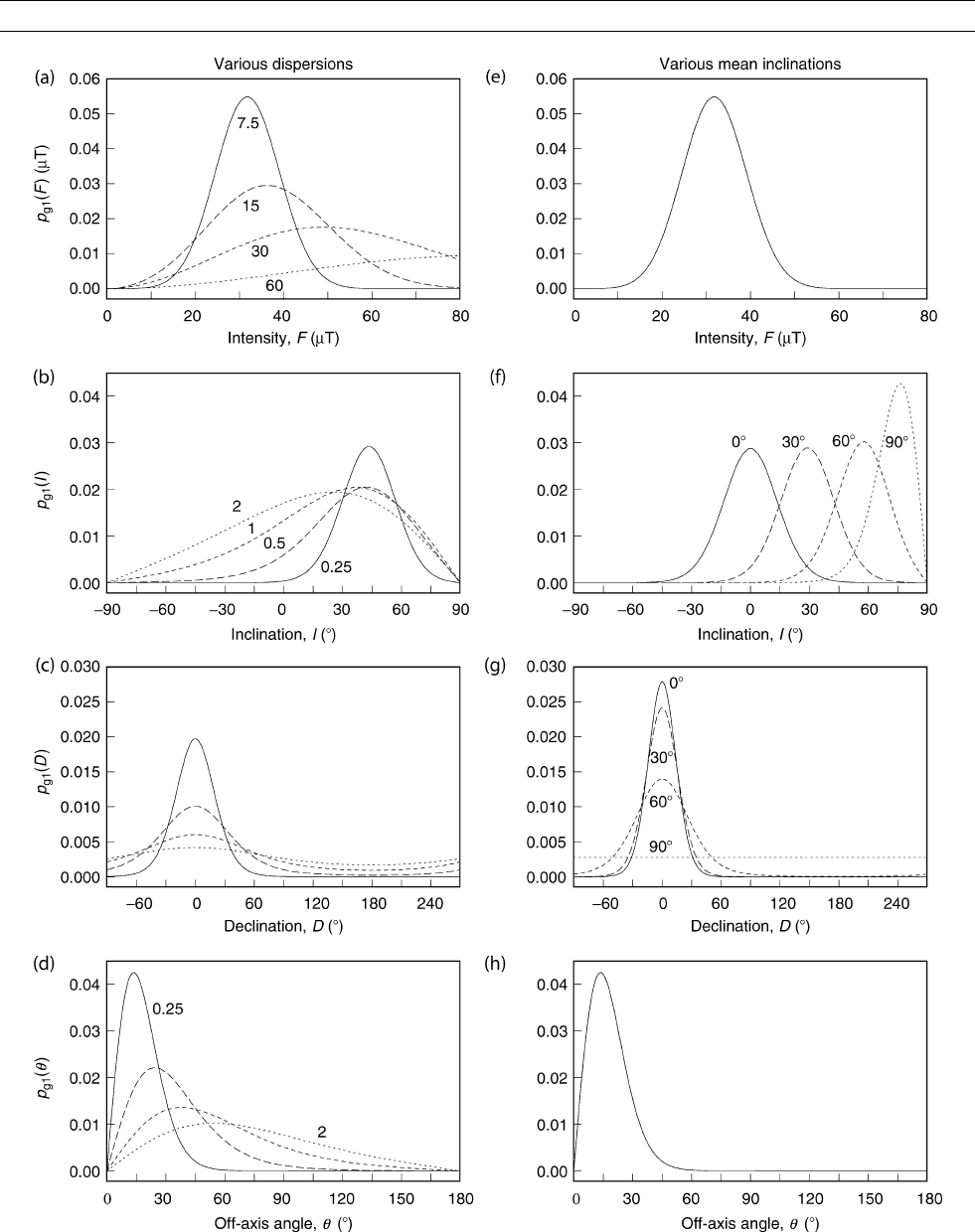
Figure S46 Examples of the marginal probability-density functions p
g
1
for the Gaussian distribution (7). (a) Intensity F, with
vectorial-mean intensity F
m
, and with vectorial dispersions s of 7.5, 15, 30, and 60 mT, shown, respectively, by solid, long-dashed,
short-dashed, and dotted lines. (b) Inclination I, (c) declination D, and (d) off-axis angle y with vectorial mean direction
ðI
m
; D
m
Þ¼ð45
; 0
Þ, and with relative vectorial dispersions s=F
m
of 0.25, 0.5, 1, and 2, shown, respectively, by solid, long-dashed,
short-dashed, and dotted lines. Examples (e-h) are for different mean inclinations, but only the (f) inclination and (g) declination density
functions are affected; for vectorial-mean values of ðF
m
; D
m
; sÞ¼ð30 mT; 0
; 7:5 mTÞ the solid, long-dashed, short-dashed, and dotted
lines are for vectorial-mean inclinations I
m
of 0
,30
,60
, and 90
, respectively.
924 STATISTICAL METHODS FOR PALEOVECTOR ANALYSIS
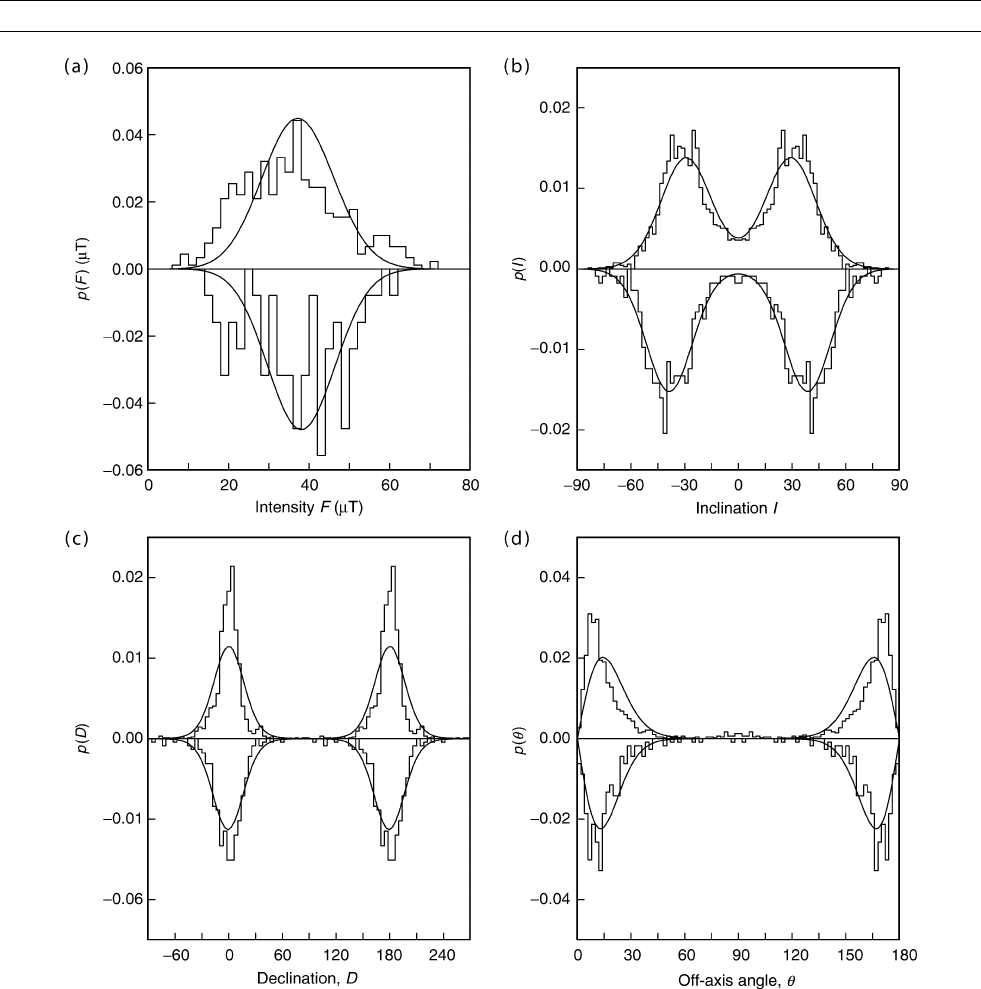
this corresponding to the Bingham distribution so often used by the
paleomagnetic community for bimodal directional analysis. As with
our comment about intensity distributions, because they are directly
linked to the 3D Gaussian distributions, and because they apply to
the complete range of possible vectorial dispersions, (16) and (17)
are suitable for most paleodirection studies.
Maximum-likelihood estimation
In fitting paleomagnetic data to a particular Gaussian distribution,
thereby yielding a measure of mean and variance, a convenient method
is that of maximum-likelihood; for a general review see Stuart et al.
(1999). With this formalism, the likelihood function is constructed
from the joint probability-density function for the existing dataset.
In our case we use the Gaussian density functions and/or their
appropriate marginalizations to construct the likelihood, which, in its
most general form, for all normally encountered types of data groups,
is just
L ¼
Y
N
FID
j¼1
p
g
F
j
; I
j
; D
j
Y
N
ID
k¼1
p
g
I
k
; D
k
ðÞ
Y
N
FI
l¼1
p
g
F
l
; I
l
ðÞ
Y
N
F
m¼1
p
g
F
m
ðÞ
Y
N
I
n¼1
p
g
I
n
ðÞ: (Eq: 20)
Figure S47 Comparison of maximum-likelihood fits of the 3D bi-Gaussian distribution to the (positive, top) Hawaiian data and
(negative, bottom) Re
´
union data covering the past 5 Ma. Both the probability-density functions and the histograms of the data are
shown for (a) intensity, (b) inclination, (c) declination, and (d) off-axis angle. Note that the Re
´
union data, particularly the declination
and off-axis angle data, are fitted better than the Hawaiian data, also note the sizable difference in mean inclination between these two
sites.
STATISTICAL METHODS FOR PALEOVECTOR ANALYSIS 925
